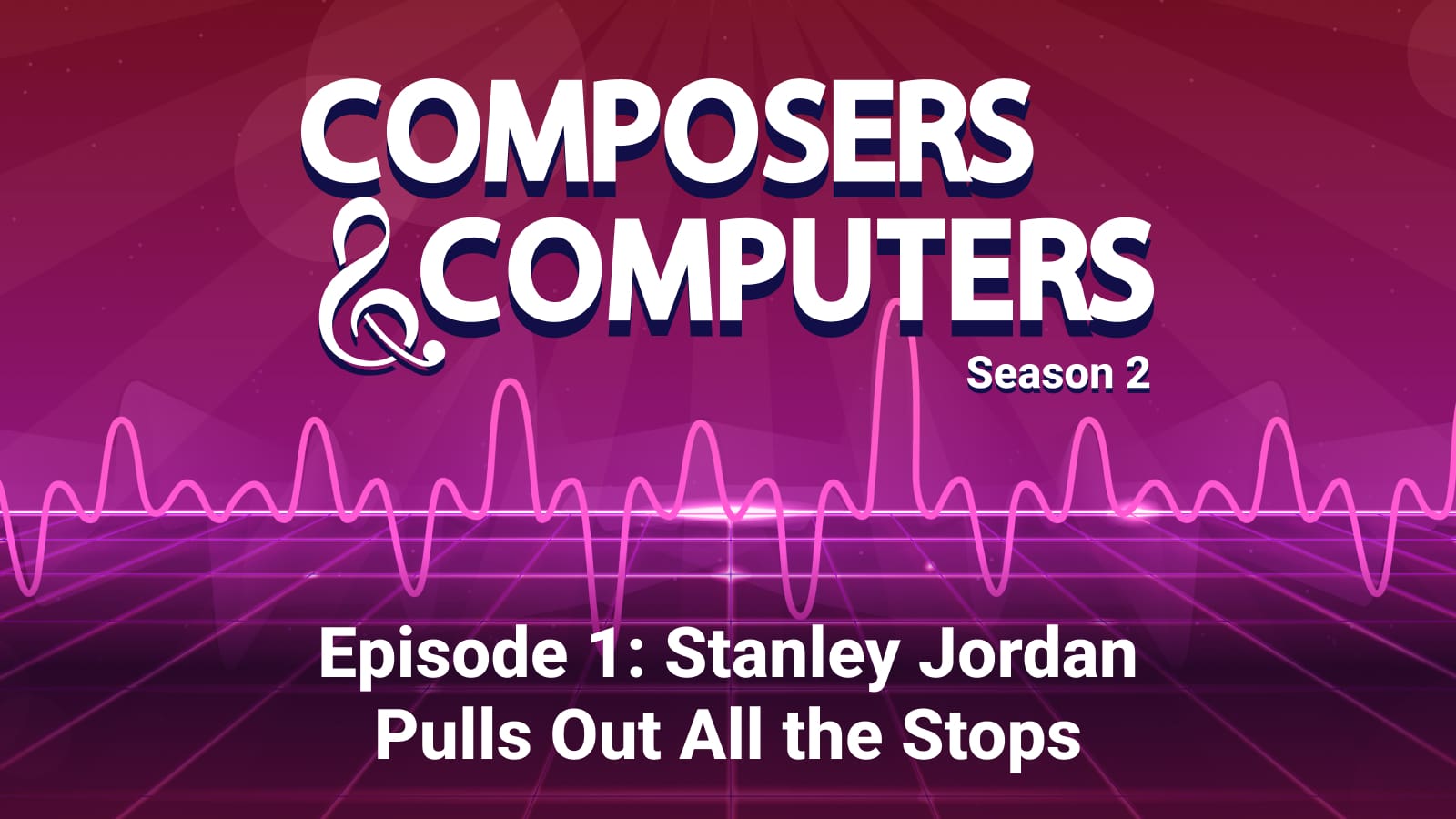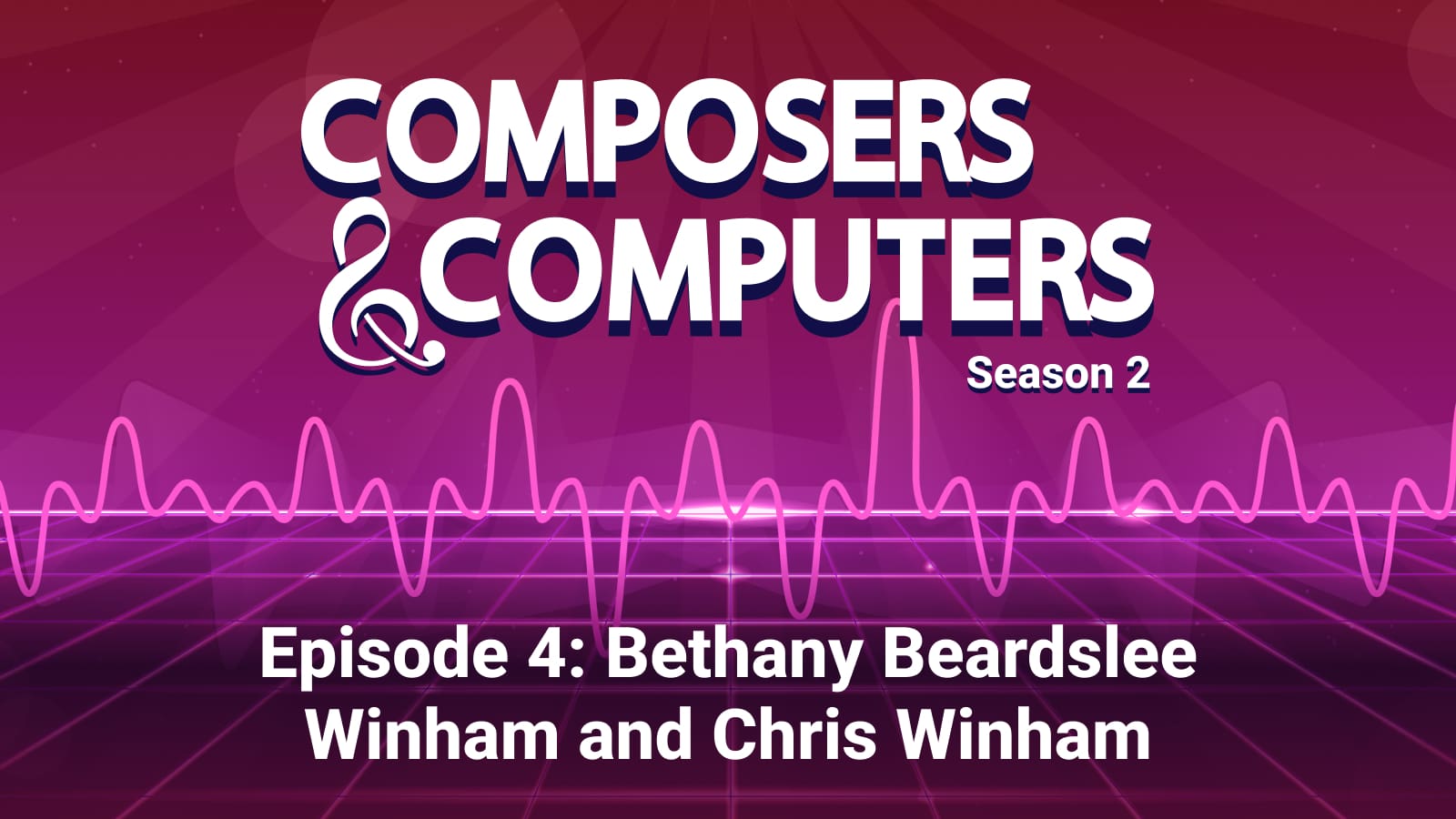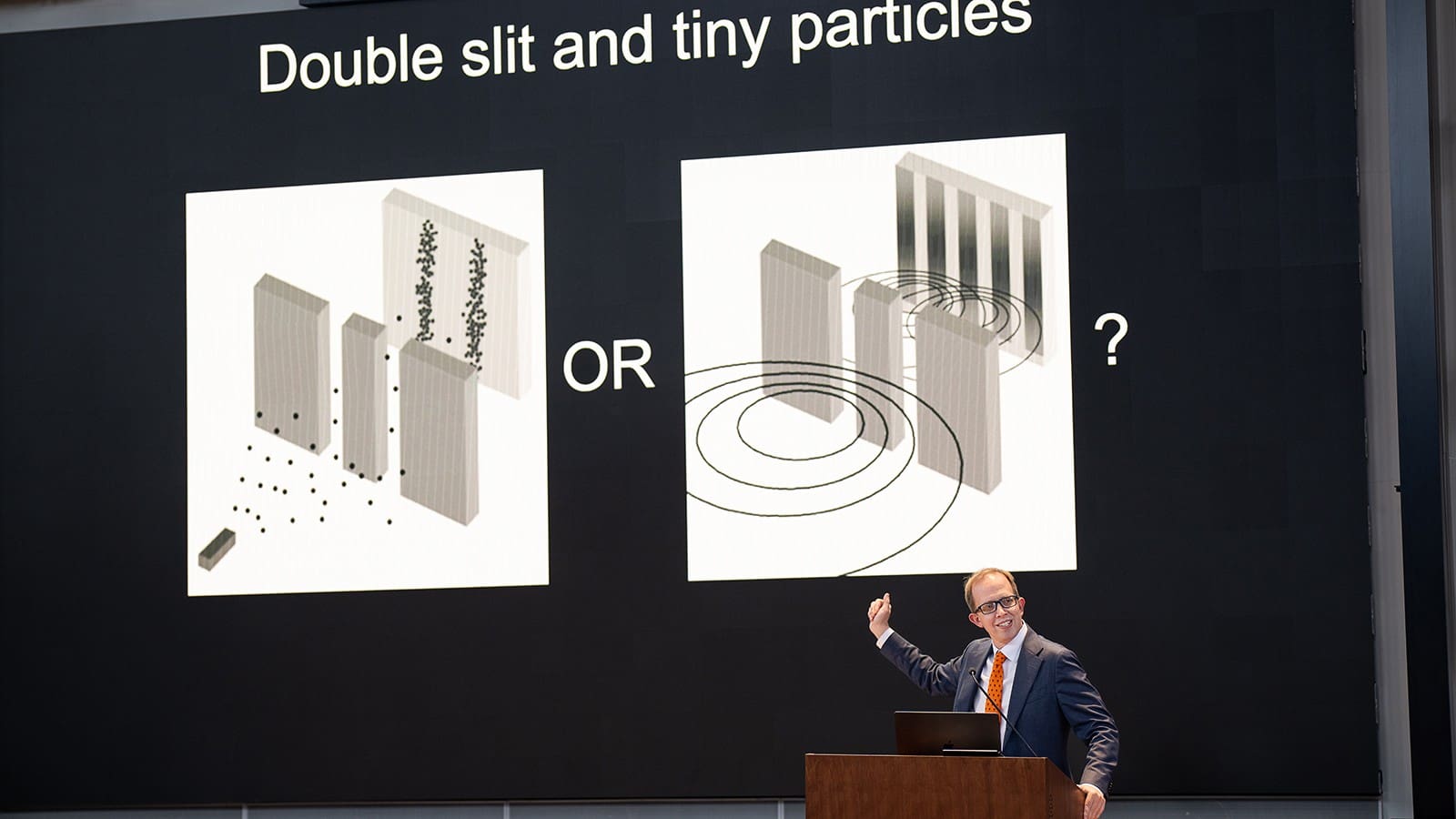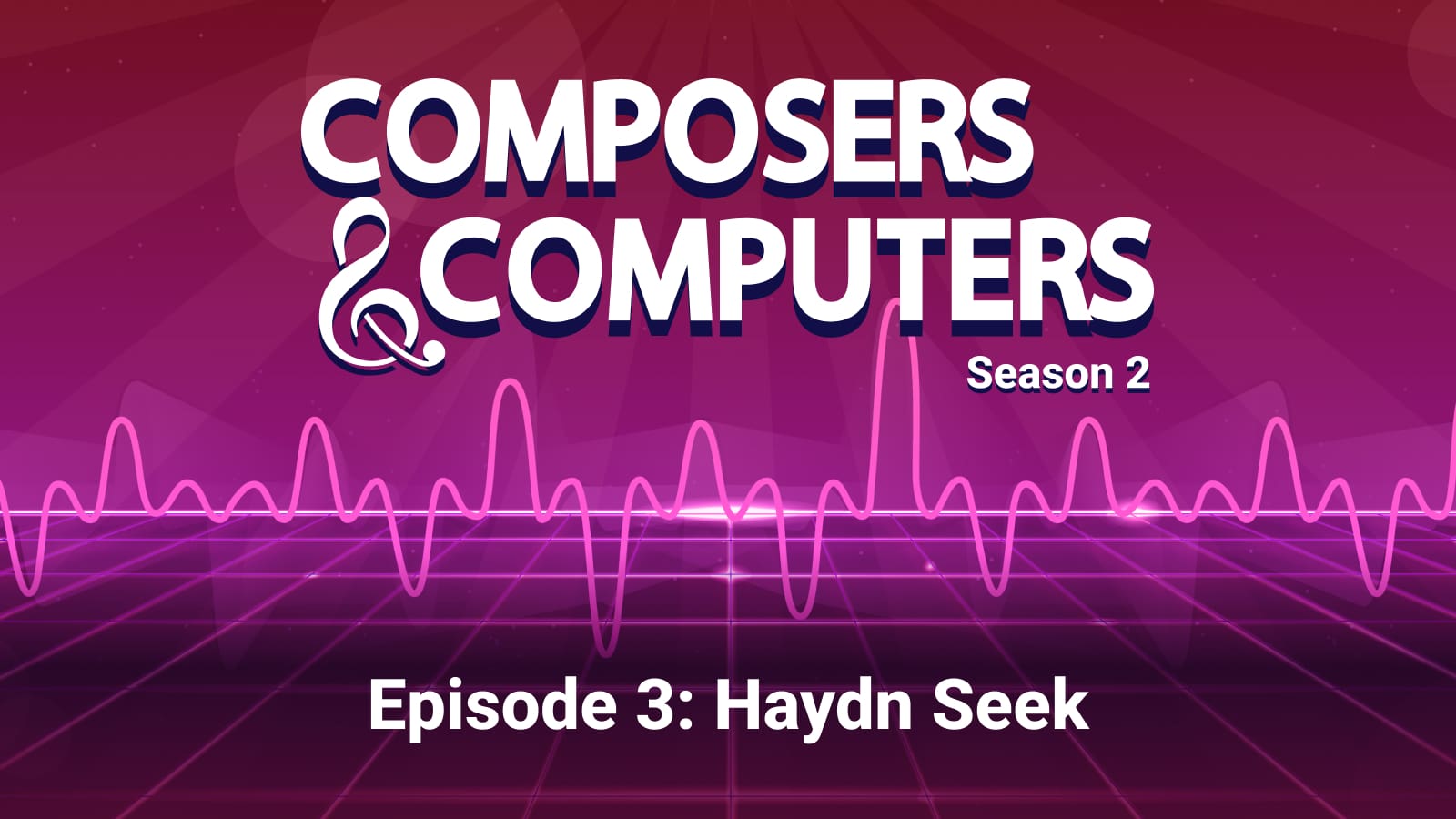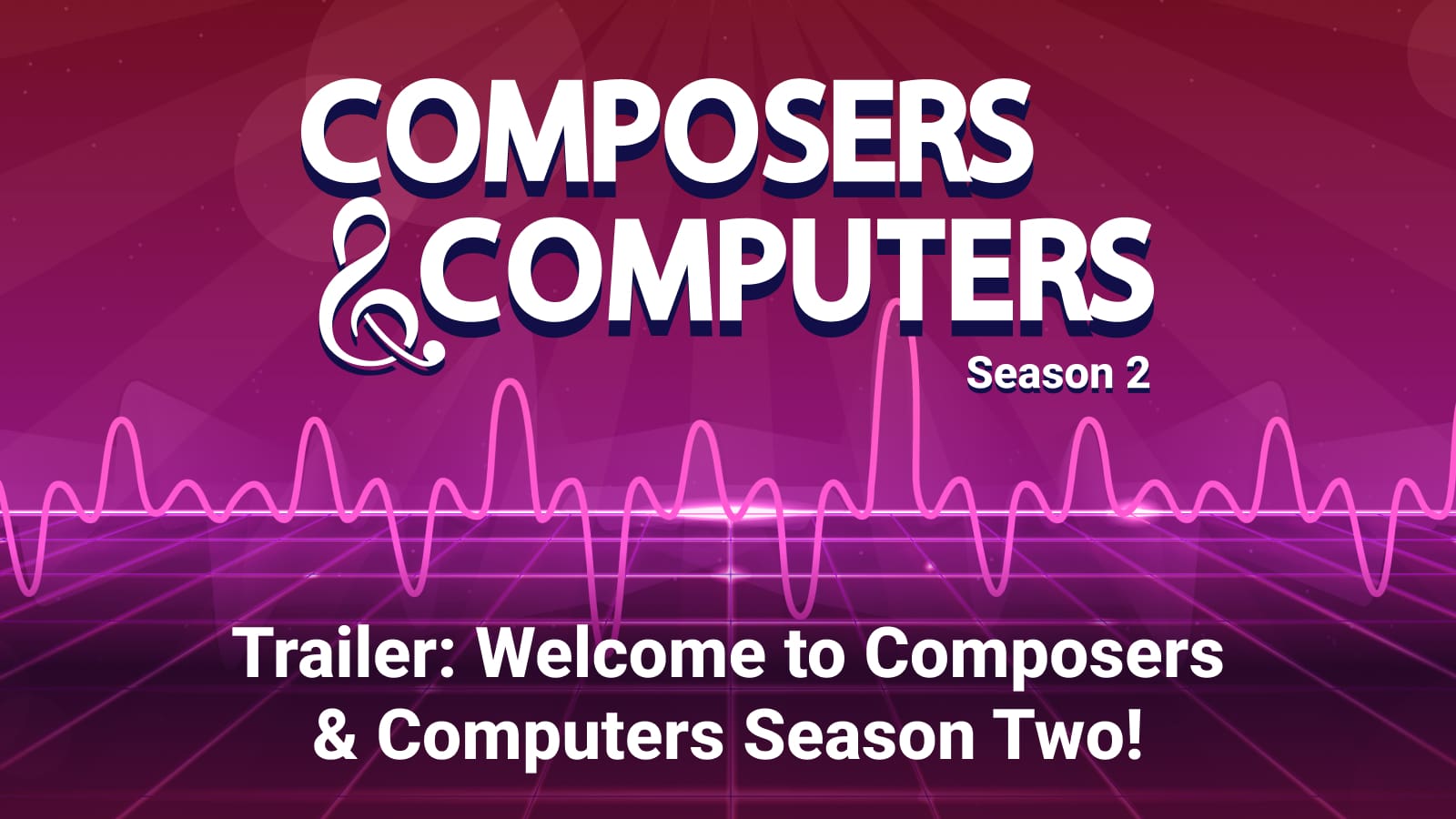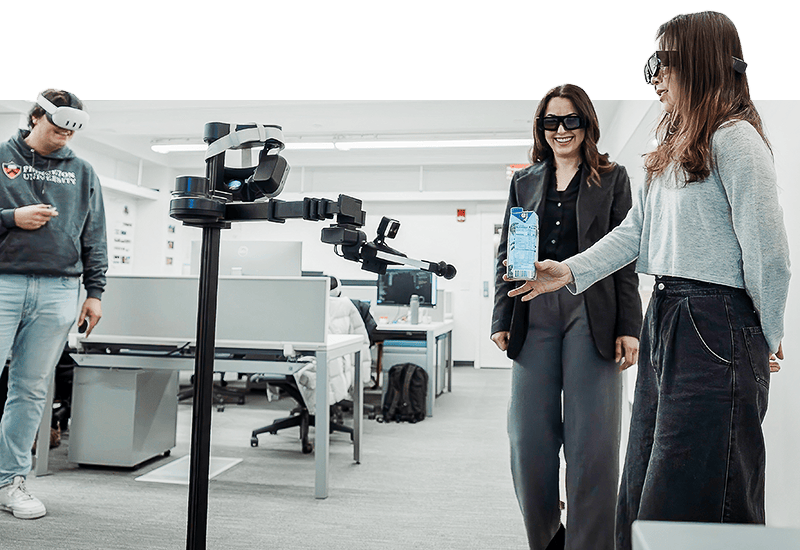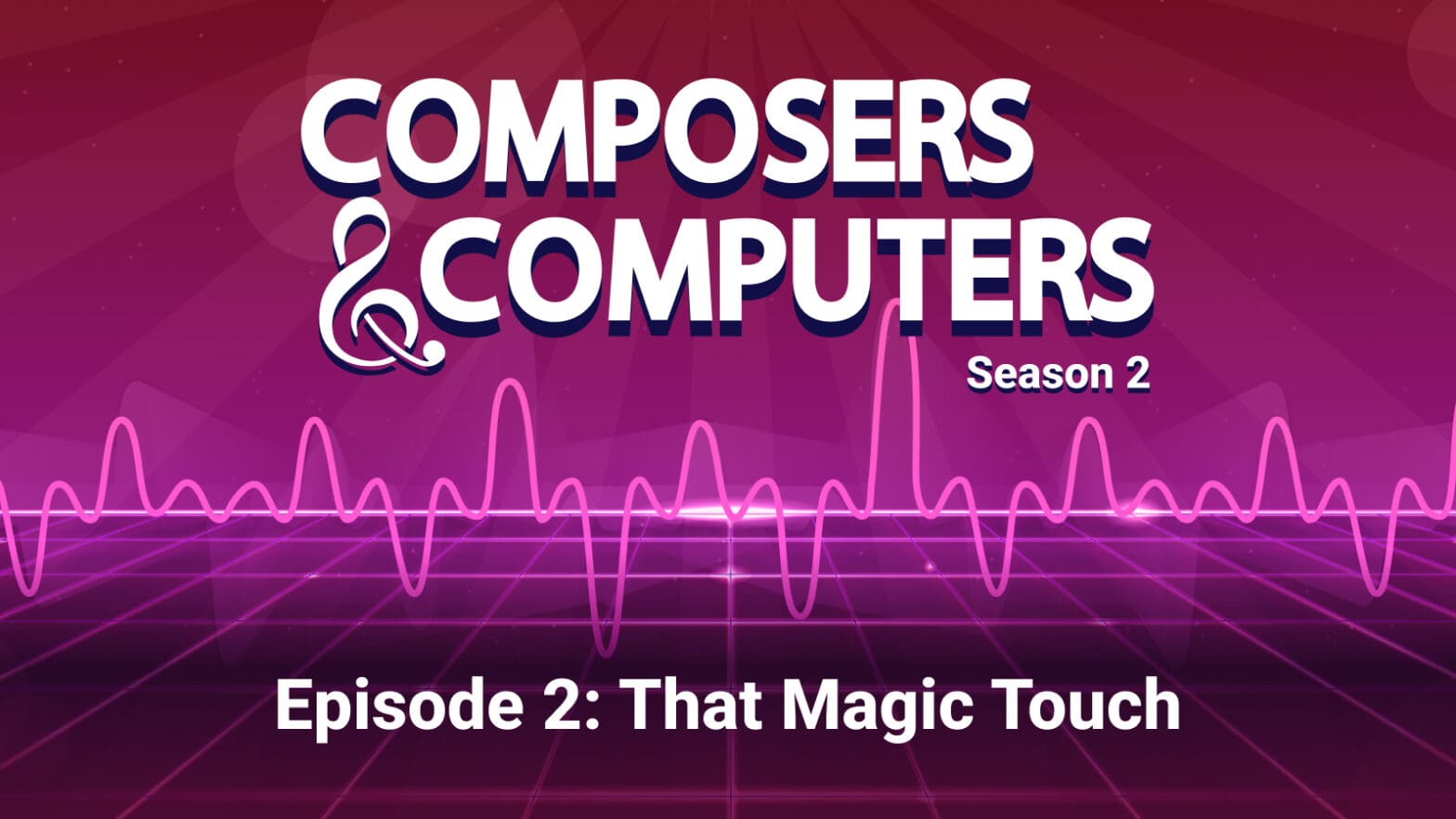
Episode 2: That Magic Touch
By
on
This is from the series Composers & Computers, a podcast
When Stanley Jordan ’81 was a student at Princeton, coaxing sound out of a computer was quite an undertaking. He’d leave his dorm room at Princeton Inn and trudge through the snow to the Computer Center on Prospect Street, where he would submit his punch cards.
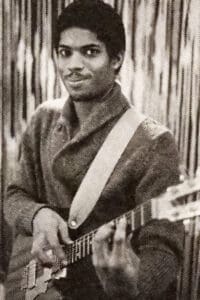
The cards would be converted to digital tape, which he would then walk over to a basement lab on the far end of the Engineering Quadrangle. The mini-computer there would convert the code from digital to analog form, and he would hear his composition for the first time.
But inevitably, there would be an error… And he’d have to retrace his steps, returning the tape and then heading home to alter his composition. And the cycle would repeat. But he said it was worth it.
“The idea was so thrilling for me, because I had this sound in my head, and I knew that if I could just get the right numbers, create the right code, I knew there was a way to realize that sound… So I didn’t mind trudging through the snow at midnight. I think sometimes when something is challenging, I think it’s more meaningful.”
In episode 2 of Season 2 of “Composers & Computers,” Jordan talks about his time at Princeton, including his work with two of his mentors, who were big names in the field of electronic music: Milton Babbitt and Paul Lansky. He discusses the time Dizzy Gillespie’s jaw dropped when Jordan took the stage during a concert at Richardson Hall with Benny Carter.
And he talks about that time he was playing The Tonight Show with Johnny Carson, and with seconds go before cameras rolled, the sound wasn’t coming out of his guitar. His guitar tech was sweating bullets. Was he able to hit his mark? And what lesson did he learn from the experience? You’ll have to listen to find out.
Bonus content:
Music played on this episode
“Round Midnight,” composed by Thelonious Monk, performed by Stanley Jordan
“One for Milton,” Stanley Jordan
“Compositions for Piano,” Milton Babbitt
“Shadows,” Paul Lansky
“Ain’t She Sweet,” Ager/Yellen, performed by Benny Carter
Transcript
[00:00:00] Stanley Jordan: The idea was so thrilling for me because I had the sound in my head, and I knew that if I could just get the right numbers to create the right code and generate the right numbers, I knew that there was a way to realize that sound, no matter what the sound was, there was a way to realize that sound. And for the first time in human history, we had that. So I didn’t mind trudging through the snow at midnight. It was amazing. And the idea, I think sometimes when something is challenging, I think it’s more meaningful.
[00:00:31] Aaron Nathans: That’s Stanley Jordan, jazz legend and Princeton University Class of 1981 graduate, talking about his experience creating music at the Princeton Computer Center while he was a student here.
At the time, only a small number of people specialized in making music with a computer. Analog synthesizers were all the rage, and electric guitars were ever present. But that’s very different technology from making music with ones and zeros. In this second half of our interview, Jordan will speak about two of his mentors at Princeton, the computer music maestro Paul Lansky, as well as Milton Babbitt, a famous composer who made complexity his calling card.
But we’ll start this episode with his memories of appearing on The Tonight Show with Johnny Carson. And he’ll talk about the fact that no matter how successful he became as an electric guitar-based jazz musician, when he was out of the public eye, he never really stopped making computer music.
From the School of Engineering and Applied Science at Princeton University, this is Composers & Computers, a podcast about the amazing things that can happen when artists and engineers collaborate. I’m Aaron Nathans.
Season two, episode two, That Magic Touch.
[00:01:57] Stanley Jordan: See, my Magic Touch album came out in ’85, and that album did really well. It was number one on the jazz chart for, like, 51 weeks.
And I did a lot of international touring, and I got real busy going out in the world and bringing my music. But it was all conventional guitar. I did use some effects, and over time, I started to use more effects, but it became really cumbersome because all those racks of equipment were really complex to use. I remember one time we did the Johnny Carson show, and everything sounded fine in sound check, and we were about to start, and they’re raising the curtain. The stage manager is counting down. Ten, nine, eight. And my guitar tech is like sweating bullets because there’s no sound.
He’s like, what’s happening? There’s no sound coming out. And he’s like, trying to figure it out. Seven, six, five. And the stage manager is watching this whole thing go down, and he says, fade to commercial. And I say, no, it’s okay.
Four, three, two, boom. And the sound comes on, and we play the song.
My guy’s going to figure it out. I just knew it.
[00:03:27] Aaron Nathans: That’s faith.
[00:03:28] Stanley Jordan: Yeah.
[00:03:30] Aaron Nathans: Wow. And what do you think he did to get that?
[00:03:33] Stanley Jordan: I don’t know. It’s just one of those things. But my point is that it was a complex system, and that’s the kind of problem that you get when you have a complex system like that. And so I scaled down, and then at the same time, we’ve got this process that Bucky Fuller called ephemeralization, where through technology, we learn to do more with less. So nowadays, just a couple of pieces of equipment can do what two racks did in the past, so it’s a lot more practical. And I ended up donating a lot of my old equipment, and it’s cool now, but at the same time, the purely digital synthesis and using the computer as a musical instrument, that’s something that I’ve continued to do. And there’s going to be some new works, some new things coming out within the next year or so that I’m not 100% ready to say, because I kind of want it to be.
I want to reveal it. I want it to be more new when I reveal it. But I’m really excited about it, because a lot of the stuff that I started during those days at Princeton, that’s been under wraps and kind of a background task for decades now, is now going to start to come through, and I’m going to combine it with the education and the science, and there’s, like, a whole thing that I’m going to be doing.
[00:05:04] Aaron Nathans: Wow. Well, that does sound cool. You and I had talked over email about the fact that you don’t really have a lot of computer music left over from your Princeton days. You don’t have any from your days at Princeton, but maybe I asked the wrong question. You’ve continued to make but not release computer music since you left?
[00:05:24] Stanley Jordan: Yeah, but even more than that, I’ve been just developing the tools. I think that’s a lot of it. And maybe I get a little obsessive like that because I get another idea and, oh, this is going to be amazing. And so I’ll develop that. And then before I do a whole lot with it, I get another idea to develop it even further. And so at this point, I guess the upside of that is that because I’ve been so relentlessly developing these tools, at this point, it’s gotten to such a high level that I’m really thrilled at the possibilities and the thing is, okay, today, when I listen to the electronic music landscape, and the thing that’s really predominant is the EDM, the electronic dance music.
And I’m blown away by the sounds that are available to people, to producers and DJs today. And we didn’t have anything like that back in the early computer music days. I would have loved to have that palette of sounds. So I think things have definitely advanced on that level. But musically, I’m just not that excited about the actual music that I hear a little bit.
I like some things I like, but usually when I like it, it’s because it gives me ideas. It’s like, oh, that’s a great idea.
I would love to develop that, and it triggers something else. So here’s the thing. We’ve got these electronic instruments, and not only can they make new sounds, but they can also make new music.
And what I’m really not hearing is a lot of what I would really call new music. It’s basically just using electronic instruments to play the same harmonies that were played before on acoustic instruments. But there are new potentials, new musical potentials that are opened up with these instruments. And so that’s one of the things that I’m excited about exploring. So when I do my version of EDM, it’s going to go deeper into some of these areas. There’s a sort of a branch of EDM that they call IDM, intelligent dance music.
There are some people who are kind of put in that category. I would say Skrillex would be one bass. Nectar is another one.
He’s out here in Santa Cruz. Last I knew, there are certain people who are going a little deeper into the musicality of it.
But I think for the most part, the EDM world is not that tuned into the musical advances that were commonplace during the traditional computer music days.
There’s a website out there somewhere where it’s actually well done and it’s very comprehensive. They talk about all these different styles of EDM. They give you examples. They have it really well classified. Well, all the computer music stuff is classified under down tempo, which is kind of like one of the songs that I did at Princeton is called My Martian Cousin.
It’s an uptempo song.
It’s not down tempo, but just sort of the idea that, well, it’s all about the beat. So we’re going to classify that as downtempo because most of that stuff doesn’t have, like, a regular repetitive beat. And basically, the author of the website basically scoffs at all that music, and it’s like it just went right over his head.
And I think that the time is right for a resurgence. Music that’s got more interest and depth harmonically, and more complexity in the structure. We’re still in the vestiges of this record industry, where corporations made tons and tons of money marketing simple music to kids. And I’m not knocking it because I was one of those kids, and I enjoyed that music. I enjoyed the grassroots and all that stuff. But there’s a natural tendency of art to evolve, and I think that the corporate bully system kept it down. And now it’s at the point where the music has been deconstructed to the point where no one really even cares about music anymore. It became the background to a video, and now they don’t even show you the video anymore. People don’t really care about music like they used to. But I think that some amazing new music that opens the mind, that stimulates us in novel ways, is edifying. I think there’s a place for that, and I’d like to try to make a contribution to that. So I’m really excited about the potentials of this future coming forward.
[00:10:41] Aaron Nathans: At first glance, it would seem that Stanley Jordan and the late Milton Babbitt had little in common other than an appreciation for synthesized music. Babbitt was a strict serialist composer who inhabited classical music halls, and Jordan would go on to become an innovator in guitar-based contemporary jazz, playing at clubs and theaters around the world. Jordan wrote in a recent research paper about the moment he “got” Babbitt’s music during a lecture, when Babbitt played a singular chord, inspiring Jordan to involuntarily stand up in his seat in awe. Jordan had been looking for a way to reach out beyond the traditional confines of jazz music to make his music more expressive, and with Babbitt, he found it. Jordan learned to play haunting, tension packed augmented chords and scales rarely used in jazz up to that point. Upon Babbitt’s death in 2011, Jordan created this piece in his memory. It’s called one for Milton, and you can hear Babbitt’s influence.
Babbitt, in turn, was said to have listened to jazz in his spare time, and Jordan notes that influence shows in Babbitt’s less than traditional approach to classical music.
[00:12:25] Stanley Jordan: Milton was a huge inspiration for me in terms of music theory, because, as I mentioned before, I had already been interested in the sort of the mathematicalization of musical structure, and I had developed this system that I called the chromatic system, and I didn’t know anything about Milton, but I was using the numbers zero through eleven for pitch classes. I didn’t use the word pitch classes, but I remember when I first got to Princeton and I met another freshman, Laura Berman, who was just as passionate about composition as I was. She knew for sure she was going to major in music. So here it is, freshman week, and we’re talking, and I tell her about this system, and she said, oh, Milton Babbitt already invented that. And I said, really, where can I find out more about him? And she said, he teaches here. So that was just going back, to Dr. Chowning saying, yeah, maybe Princeton would be even a better place for you.
I realized even more what he was thinking when he said that. So, naturally, Milton was an amazing teacher. I did publish a paper early in 2022 that kind of goes into the history of that and Milton’s influence. It’s called Milton Babbitt’s Type E All Combinatorial Hexacord and its Applications to Jazz. And the thing of it is, a lot of the stuff that Milton developed is applicable to jazz, but people don’t know that. And as an improviser, these structures are really fascinating for me because they can be used as an extended vocabulary. And when I showed Milton my work, he said, this is original work. You don’t have to go out of your way to imitate what I’m doing or what other people are doing. This is your system, and you should develop this in your own way. Because, for example, the idea that a zero 116 is not just some aggregate that occurs as part of the unfolding of serial structures, but just to play it as a chord, like a jazz chord, and make a tune where zero 116 is one of the tunes in the chord. He said he didn’t think of that. That’s something different. But that was something that naturally just came to me from my jazz orientation. And, in fact, what’s nice about this system using those integers is that it makes it easier to conceive of these more complex and unusual harmonic structures. And that’s especially useful because anything that can make your mind processing more efficient, what Jim Randall called head time, you want to reduce head time. Anything that can reduce head time is going to be useful as an improviser, because when you’re playing in real time, you can’t stretch the clock, like, know this is the time, and you got to come up with the next idea in the available time. So anything that’s going to make your mind processing more efficient, it’s going to effectively increase your vocabulary, because there might be stuff that you know, but it takes you too long to put it together, and so there’s more stuff that’s available to you in that moment.
[00:15:53] Aaron Nathans: In the main podcast, we discussed the Princeton musicians who were pioneers at using computers to synthesize music. We talked about how they used the room sized IBM in the 1960s and 70s, even spilling into the 1980s, to realize their works. But because zeros and ones make no sound, there was still another step. Until 1970, they needed to drive across New Jersey to Bell Labs to convert their music from digital to analog form so they could hear it. But that year, Princeton music professor Godfrey Winham and engineering professor Ken Steiglitz created a device that could do that job on site within a lab in the basement of the Engineering Quadrangle. After Winham’s passing, it was named after him, the Winham lab.
In this portion of our conversation, Stanley Jordan reflects on finding his own way through that process, as well as the time he spent in the Winham lab. And he talks about the inspiration he took from Paul Lansky, the master computer musician who was on the faculty in the music department.
[00:16:53] Stanley Jordan: That room. I do want to talk about that room in the EQuad, because I want to give people some context of how the system worked. Because even when I had my APL front end, I would generate all these notes. But the only way to actually hear the notes is, I had to go to the computer center.
And my first couple of years, I lived at Princeton Inn. So I think they changed the name, but all the way on the other side of campus. So I would have to walk all the way from there to the end of Prospect Street and go to the Computer Center. And then I would fill out a form, and I would check out a digital tape, because my job, it was like a batch job, and the sound would get generated and stored on a digital tape at the Computer Center. So I had to go to the Computer Center, fill out a form, then they’d bring me the tape, and they’d put it in a bin. Then I would take that tape, and then I would go into the Engineering Quad. And down in the sub basement, there was this room, the Godfrey Winham lab. And in that room, you spool the tape onto this mini computer, a PDP, whatever it was. And you had to boot up the whole system. And sometimes the data would get corrupted, and you’d have to reload the bootstrap loader, and there’s all this stuff, and you’d have to fill out a log saying the time in, time out, and all that kind of stuff.
And you set everything up, and then you push the start button and you hear the music, and it’s like, oh, it sounds like that.
Okay, back to the drawing board. So then I go back, bring the tape back to the Computer Center. I have to check out, turn everything off, go back to the Princeton Inn, get in there and change, like that one note or the one thing that was wrong. And, I mean, I’m talking about this could be like midnight in the winter, trudging through the snow. I mean, it’s like one of those classic, know, when I was your age, you know? But, I mean, that’s really how it was. But the idea was so thrilling for me, because I had the sound in my head, and I knew that if I could just get the right numbers to create the right code and generate the right numbers, I knew that there was a way to realize that sound. No matter what the sound was, there was a way to realize that sound. And for the first time in human history, we had that. So I didn’t mind trudging through the snow at midnight. It was amazing. And the idea, I think sometimes when something is challenging, I think it’s more meaningful. Like, I spoke with Paul years later about this, and he said that he wasn’t doing computer music anymore, because all these new systems, it’s so easy now. But back when he was doing it, it was a big deal. And he was doing things that had never been done before. And that ethic of getting that sound out, because I want to share this sound with the world. The world needs this sound.
He embodied that ethic. I don’t think anyone embodied that ethic more than Paul did with the punch cards. And the amount of time that he spent on his compositions and they would finally be done was just…
Plus, you know, I just love Paul Lansky. He’s just such a nice guy. And really, what a musical ear. I mean, as a composer, his sounds are just so lush and so satisfying to hear, just so beautiful and so enjoyable. Some people are just born for sound. Paul is one of those people. And he was also a really good sounding board and life coach. I remember him giving me some advice about composition, because at one point, I was taking things maybe a little too seriously, and I was getting so caught up in perfectionism that it was interfering with my productivity. And he said, composition is just a thought, simple and unjudged. And I can still feel the sigh of relief that I felt when he told me that. It’s like, yeah, right.
And another thing is that Paul is one of the few people in the sort of serious contemporary classical composition world whose pieces have gone beyond that world and have hit the mainstream to a degree. I mean, sometimes I hear his compositions on Sirius XM radio. I’m like, ooh, I know that guy. And I remember one time I was talking with some random guy in a bar somewhere, and I mentioned that I studied with Paul Lansky, and he knew who he was.
In fact, I told Paul that story, and he said, oh, great, so my music is made it to the bars.
But he was really so supportive and so inspirational, and during those days, he knew the system like the back of his hand. So if I had some different interesting thing that I wanted to do on the system, he knew how to do it. I remember one time there was this woman who was a psych major, and she was doing an experiment for her thesis where she wanted to see if babies responded differently depending on the frequency of the voice, and using that as a hypothesis for why people tend to use a high pitch when they talk to babies. And so she wanted to take a sound and filter it in different ways and play it for babies to see how they responded. And so she came to me for that because she knew that I had this system that could process sounds. So what we did is we took that sound of the mother’s voice and processed it using a very steep slope, low-pass filter and changing the center frequency. And I gave her different versions of the recording, and it was the higher frequencies that got a better response. Well, Paul was the one I went to because I said, Paul, I need a filter that’s just got the steepest cutoff slope possible. Can you hook me up?
Anything? Any question I had, any technical question about the system. He was able to help me with that and just so generous with his time. So that was really a blessing, getting a chance to study with Paul and with Milton, too. A lot of who I am today are because of the shoulders I stood on, including those two.
[00:23:41] Aaron Nathans: Well, here are a few memories that Paul sent me by email. Dizzy Gillespie’s jaw dropping at a concert in Richardson with Benny Carter. When Carter invited Stanley to play a number, I take it you probably remember that.
[00:23:53] Stanley Jordan: Yeah. So Benny Carter taught at Princeton for one semester. He co taught with Morroe Berger in the American Studies department. And the course was something like jazz in American society or something like that. So it was an interdisciplinary course between the music department and the American Studies department that was focused on jazz. So here we had one of the jazz greats, and going way back, too.
And so one day, I kind of got my nerve up. And I went to his office hours and I brought my guitar and I played for him and he brought out his horn and we did some playing together.
And I said, I know that you have this concert coming up in a couple of days with Daisy Gillespie. Do you think I could maybe sit in? And he said, sure. So they invited me up at the beginning of the second half and a lot of my friends were in the audience, so I couldn’t have asked for a more supportive audience. And it was a life changing experience for me as well because not only was I able to play with these great musicians, but I really felt that what I played was making a contribution. And it seemed like they were inspired by what I was playing as well. And I think that the love and inspiration from the audience definitely helped as well. So that was a turning point because that was really my first big appearance at Princeton.
[00:25:38] Aaron Nathans: You’re listening to Season Two, Episode Two of Composers & Computers. We’re speaking with Stanley Jordan, the legendary jazz guitarist who received a Bachelor of Arts in music from Princeton.
He’s speaking about his experience studying computer music at Princeton and how it informed his career as a recording and performing artist, as well as what he has planned for the next phase of his professional life.
In our next episode, Stanley Jordan does something remarkable. Remember, he has no computer music recordings left over from his time at Princeton, but he did have some notes and he used them to rebuild and finish his composition just for us.
I can’t wait for you to hear the world premiere of the completed edition of Stanley Jordan’s piece “Haydn Seek,” 42 years in the making.
If you’d like to learn a little more about Stanley Jordan, the recording and performing artist, we invite you to check out some bonus content on our website. It’s an interview with Bill Meredith, a freelance music writer based in southern Florida. He’s written multiple articles on Stanley Jordan. In our conversation, Meredith said Jordan hasn’t always followed the easiest path to commercial success.
[00:26:55] Bill Meredith: He didn’t really want to be a pop star. He didn’t want to be something that he didn’t see himself as in the first place. There’s a quote I found in one of the stories I wrote that I thought was really telling, and I ended a story with it. “Not to be too dramatic here, but you’d rather be hated for being who you are than loved for being who you’re not.”
[00:27:20] Aaron Nathans: You can find the interview with Bill Meredith in our show notes, available on our website, engineering princeton.edu.
Okay, back to our conversation with Stanley Jordan.
[00:27:30] Aaron Nathans: Your music, I mean, the word soulful is thrown around so much, it’s almost lost its meaning. But if anybody is soulful, it’s you. I mean, having listened to a lot of your music over the last week, it comes from a very deep place. How do you square that with your love of the computer, right? I mean, if anything doesn’t have a soul, it’s a machine. You are one person, and you love both these things. And you love many things. You’re a renaissance person, for sure.
How do you fuse the coldness of a computer with the possibilities of animating what it means to be human?\
[00:28:10] Stanley Jordan: I love that question. Thank you. I think the basic key to it is to never let them get separated in the first place.
For me, the computer stuff was something that fortunately, I learned from an early age, and so it just always came naturally to me. And playing music on an instrument always came naturally to know. I remember when I was in college, and I had some creative friends who would get together and we would build stuff. And one of my friends, Matt Heron, was a brilliant visual artist. And we built this system where you could project lasers, and we had rotating mirrors, and I created the electronic part, he created the mechanical part. And while I was doing the musical performance, he was doing the laser show. And so we had a bunch of creative friends who would get together and tinker and create stuff like that. And I remember that my friends, I wasn’t majoring in engineering, but I was just sort of absorbing it by osmosis. And so my friends would, let’s say we needed an oscillator to oscillate at a particular frequency range. And so they would say, oh, we just learned that. Let’s see. So there’s a formula to that. And they’re, like, going back and trying to remember the formula. Meanwhile, I’ve got this shoebox, and I’m like, okay, I’m going to use this capacitor and this resistor, and I just put them together and boom, it just goes right to the range that we’re looking for. Because I just had an intuitive sense. I know that the bigger capacitor is going to give me a lower note.
I just had a sort of an intuitive sense of that sort of thing. And so that I didn’t have to think of it in a dry sort of way. And there’s a school of thought, I don’t know. I haven’t looked into this enough to have an opinion on it, but there’s a school of thought that says that it’s actually healthier. Not to teach kids to read when they’re super young, but to let them grow up in a more sort of intuitive way. And then when they reach puberty or whatever, then teach them to read and then boom, they learn really quickly. But the idea is that their brain develops in a more naturalistic way and then the written language is on top of that and they actually end up with a better foundation and they end up reading just as well, but they have a better foundation because they’re not so caught up.
Like Hayakawa said, the map is not the territory. I think the danger is that if you learn to read too early, then you’re caught up in the map and not the territory. I don’t know what the source of this issue is, but I think a big problem that human beings have is we’re stuck in the matrix, we’re in our head, and I certainly have been guilty of that plenty myself. But we’ve got the idea of the thing rather than the thing itself. And I’m really fortunate that I grew up in a place that not only encouraged people to learn math and science and tech and all that, but also was an important place for a social and cultural revolution and getting back to sort of the basic humanism. And so I learned meditation when I was really young. I remember one of my best friends, he taught me progressive relaxation when I was eleven. I still use it. I did it just this morning. I don’t know, I’d be a whole different person if I didn’t know about getting totally relaxed. So all those things, the integration of it, we have this word, holistic, holistic, whole this and whole that. Okay, well, that’s fine. But as Ken Wilber points out, maybe a better word is integral and integralism, because too much holism can lead to a lot of these sort of top down hierarchies that we’re struggling with today, even on a political and economic level. Whereas integralism is where you’ve got the whole and the parts and you’ve got a sort of a wider spectrum where at every level things are working together. I think that is ultimately where we should be trying to go. And just speaking of Ken Wilber, a lot of what his work has been about is healing the split of modernity. Modernity distinguished the good, the true and the beautiful. And that’s been really, you have to give each one its due. Kant figured that out and that’s all great. But then the split has fractured into dissociation. And now part of our job for the postmodern world is to heal that split. And so if you can figure out a way to create that integration early on and not let those parts fly apart to begin with, then you’re going to end up being much better off in the long run.
[00:33:37] Aaron Nathans: Any final thoughts? Any thoughts about Princeton?
[00:33:41] Stanley Jordan: One of the memories that I have that people have told me is sometimes people would just come to my room because they wanted to hear weird futuristic music. And I always had some weird sounds going on. And also I lived at Terrace Club and people would say, we knew you were here because we found little electronic components like diodes and capacitors and stuff. So we knew Stanley was, you know, I think that it’s great when you have the opportunity to cultivate your know, the earlier you can do that, the better. And so I feel so blessed that I had those opportunities. And so I feel like today most of what I do just wouldn’t be the same without those opportunities. So I really treasure the days, those formative years. And now that a lot of the things I’ve been working on are finally starting to really gel. I’m facing this future, even though it’s a crazy time and there’s global warming and all the wars and all the socioculturally people are split. All the dangers, the possibility of the nuclear stuff and all that. Even in spite of all these dangers, I feel more optimistic than ever because I feel like I totally agree with Jean Houston. And she would know as an anthropologist that she says, we are on the verge and it’s already in process of an awakening. She says, spirit is rising all around the world. She says, I’ve been to these places. I’ve been to diverse cultures all around the world and I can tell you it’s the same place everywhere I go. And at this point we have the combined knowledge of all of human history available to us and it’s all put together. So the possibilities of what we can do are just mind blowing. We figured out where we are. One of the things with my app, I talked about the planets and I can zoom way out and you see where we are in the Milky Way. Then you can zoom way out from there and you can see where the Milky Way is in a space of about 5000 galaxies. And you can fly around the galaxies and you can surf the filaments and sheets of galaxies. I mean, it’s only been within the last couple of decades that we’ve even had any kind of a real decent map of deep space.
We’re just coming into our own. We’re just figuring this out. We’ve got to figure out a way to build a sustainable future.
And if we can do that, and we have all the tools to actually do that, then it’s just going to be really awesome. And so my message to everyone is to stay hopeful and do what you can.
Because even in spite of all the difficulties, we are on the verge. We are on the dawn of a new renaissance. I firmly believe that.
[00:37:04] Aaron Nathans: Well, Stanley Jordan, thanks so much for taking the time to speak with us today.
[00:37:10] Stanley Jordan: My pleasure.
[00:37:18] Aaron Nathans: This has been Composers & Computers, a production of the Princeton University School of Engineering and Applied Science. I’m Aaron Nathans, your host and producer of this podcast.
Thanks to Mirabelle Weinbach for the wave sounds. Thanks to Renata Kepilevich and the Princeton Music Department and the folks at the Mendel Music Library for their support of this podcast. Graphics are by Ashley Butera, Yoojin Cheong, and Neil Adelantar. Steve Schultz is the director of communications at Princeton Engineering. Thanks also to Scott Lyon. This podcast is available on Apple Podcasts, Spotify, Google, Amazon, and other platforms. Show notes, including a listing of music heard on this episode. Sources and an audio recording of this podcast are available at our website, engineering princeton.edu. If you get a chance, please leave a review. It helps. The views expressed on this podcast do not necessarily reflect those of Princeton University. Our next episode should be in your feed soon. Peace.
